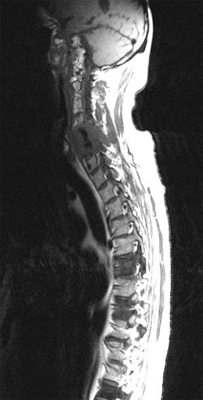- What is Metastases of the Spinal Cord
- Statistics on Metastases of the Spinal Cord
- Risk Factors for Metastases of the Spinal Cord
- Progression of Metastases of the Spinal Cord
- Symptoms of Metastases of the Spinal Cord
- Clinical Examination of Metastases of the Spinal Cord
- How is Metastases of the Spinal Cord Diagnosed?
- Prognosis of Metastases of the Spinal Cord
- How is Metastases of the Spinal Cord Treated?
- Metastases of the Spinal Cord References
What is Metastases of the Spinal Cord
Metastatic disease occurs when cancer from one site in the body spreads to another area. The spine is a common area for the spread of cancer and can cause a variety of neurological and bone related symptoms.
Statistics on Metastases of the Spinal Cord
The spine is a common site for metastasis in patients with cancer. One study found that 30-70% of cancer patients had spinal metastases at autopsy.
Risk Factors for Metastases of the Spinal Cord
Metastases of the spinal cord commonly originate from cancers occurring in the lung, breast, gastrointestinal tract, prostate and lymphomas (such as Hodgkin’s lymphoma).
Progression of Metastases of the Spinal Cord
The spread of cancer from a primary (original) site such as from the breast or lung usually occurs through the blood supply, although the exact process is not well understood. As the cancer grows in size, it can compress the surrounding structures and cause damage to the spinal cord.
How is Metastases of the Spinal Cord Diagnosed?
- x-ray of the spine may be normal but sometimes show destruction of bone associated with cancer.
- CT or MRI scanning is commonly performed to identify the site of spinal cord involvement and to see how far the cancer has spread. The MRI scan to the left illustrates multiple vertabral metastases causing spinal cord compression.

- Sometimes a procedure is performed to remove fluid from within the spine. This is examined under a microscope and often found to have abnormally high levels of protein in the setting of spinal metastases.
Prognosis of Metastases of the Spinal Cord
The long term outlook for patients with spinal metastases is generally poor, as often the disease has progressed to an advanced stage by the time a diagnosis is made. Outlook in terms of survival and prospective quality of life varies according to the amount of function the patient has at the time of diagnosis. For instance, being able to walk is a good sign, whilst loss of bladder and bowel control is a poor sign.
How is Metastases of the Spinal Cord Treated?
The primary aims of therapy are to control pain and to preserve function as much as possible. Spinal cord compression must be diagnosed and treated immediately to prevent permanent damage. Standard treatment consists of high dose steroids, with 70-80% of patients experiencing improvement of symptoms within 48 hours. Radiation therapy is usually used for treatment of spinal metastases. Surgery is not usually performed unless it is to decompress (if the spinal cord is being compressed by the growing tumour) or stabilise the spine.
Metastases of the Spinal Cord References
- Cotran, Kumar, Collins. Robbins Pathological Basis of Disease, 6th ed. WB Saunders, United States of America (1999).
- The Merck Manual of Diagnosis and Therapy: Chapter 177. CNS Neoplasms.
[available online: http://www.merck.com/] - Tierney L, McPhee S. Current medical diagnosis and treatment (40th ed.). McGraw-Hill, 2001, New York.
- Tse V. Metastatic disease to the spine and other structures. eMedicine 2004.
[available online: http://www.emedicine.com/neuro/topic626.htm]
All content and media on the HealthEngine Blog is created and published online for informational purposes only. It is not intended to be a substitute for professional medical advice and should not be relied on as health or personal advice. Always seek the guidance of your doctor or other qualified health professional with any questions you may have regarding your health or a medical condition. Never disregard the advice of a medical professional, or delay in seeking it because of something you have read on this Website. If you think you may have a medical emergency, call your doctor, go to the nearest hospital emergency department, or call the emergency services immediately.







